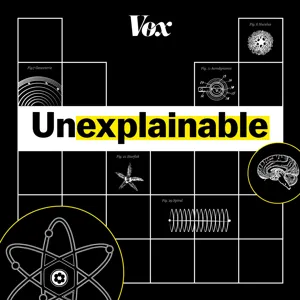Podcast Summary
A high-altitude lake in the Himalayas reveals ancient secrets: Carbon dating and Apple Card's daily cashback provide new insights and challenge our understanding of the past
Apple Card offers daily cashback of up to 3% on every purchase, which grows at a 4.50% annual percentage yield when you open a savings account. This tool, like the discovery of ancient DNA sequencing, can provide new insights and challenges our understanding of the past. The discussion revolves around the discovery of human remains near a high-altitude lake in the Himalayas, Roopkund, which has puzzled scientists for decades. Despite various theories, the origin and cause of death of these individuals remained a mystery until carbon dating was used to roughly date the bones to the 12th-15th centuries. The only significant clue was the presence of an ancient pilgrimage trail to the goddess Nanda Devi, suggesting a possible connection to religious rituals. This discovery, like the use of Apple Card, provides new information and challenges our understanding of the past.
Ancient hailstone victims' origins revealed: New DNA research suggests Roopkund Lake's mysterious skeletons came from local, Southeast Asian, and Greek populations
The legend of Nanda Devi, a goddess who punished a king and his entourage with giant hailstones, may have been based on a real event. In the early 2000s, researchers discovered evidence of skulls with depressed fractures, likely caused by large hailstones, dating back to the 8th or 9th century. However, a new study in 2015 using ancient DNA uncovered a more complex story. The skeletons found at Roopkund Lake were not all from local populations, but rather, three distinct groups. One group, Roopkund a, matched the genetic makeup of local populations. Another group, Roopkund c, was from a person of Southeast Asian descent. But the most surprising finding was Roopkund b, whose genetic makeup most closely resembled Greeks from the island of Crete. This discovery raised many questions about how these individuals ended up at Roopkund Lake, over 3000 miles away from Greece. The researchers worked to confirm their findings and continue to explore the mysteries of these ancient bones.
Ancient Diets Revealed through Carbon Isotopes: Ancient diets were determined by analyzing carbon isotopes in bones. Two distinct groups with different diets and origins were found at Roopkund Lake in the Himalayas around 1000 years ago, challenging theories about their origin and how they ended up there.
Archaeologists were able to determine the diet of ancient people by analyzing carbon isotopes in their bones. This method revealed that a group of individuals with genetically Greek features consumed a Mediterranean diet around 1000 years ago, while another group, which appeared to be of South Asian descent, died around the same time but much earlier, around 1800 years ago. The discovery of these two groups with distinct carbon signatures and genetic profiles in the same location, Roopkund Lake in the Himalayas, raised questions about their origin and how they ended up there. Some experts suggested that the bones might have been mixed up, but the consistency of the diet, dating, and genetics made this theory unlikely. The mystery of how these groups came to be in this remote and inhospitable location remains unsolved.
Ancient DNA research challenges simple assumptions about the past: Ancient DNA analysis reveals complexities and connections in history, challenging previous assumptions and leading to significant rewrites of historical narratives.
Ancient DNA research is revealing the complexities of the past that were once thought to be simple. A study on the Rupland mystery in India, for instance, uncovered unexpected genetic clusters and times of deaths, challenging previous assumptions. Despite the intriguing findings, the origins of these groups remain a mystery, leaving historians and researchers hoping for new evidence to come to light. Ancient DNA analysis can go back further in time than previously thought, leading to significant rewrites of historical narratives. For example, the origin story of humanity, which was once depicted as a simple branching tree structure, is now being reevaluated. DNA analysis plays a crucial role in these discoveries, revealing connections and complexities that were not apparent from bone structures alone. The Rupland mystery is just one example of how ancient DNA research is challenging our understanding of the past and shedding new light on the intricacies of history.
New discoveries of ancient DNA challenge traditional views of human evolution: Recent discoveries of ancient DNA have revealed that human evolution is more complex than a simple branching tree, with numerous interconnections and loops between different ancestral lines
The understanding of human evolution has undergone a significant shift in the last decade due to the discovery and analysis of ancient DNA. This new information has led us to reconsider the traditional tree model of evolution, as it appears that there are numerous loops and interconnections between different human ancestral lines. For instance, Homo sapiens and Homo neanderthalensis are known to have interbred around 45,000 years ago when Homo sapiens migrated into Europe. This interbreeding led to Neanderthal DNA being present in the European gene pool. Furthermore, discoveries of fossils and ancient DNA from other ancient human groups, such as the Denisovans, have shown that there have been multiple instances of gene flow between different human ancestral lines. This ongoing revolution in the field of human evolution research has led us to recognize that our evolutionary history is more complex than previously thought, with numerous interconnections and loops rather than a simple branching tree. In essence, the evolutionary history of humans is better described as a matted web, with various human ancestral lines interbreeding and influencing each other over time. This new understanding of our evolutionary history has significant implications for our understanding of human diversity and our shared ancestry with other ancient human groups.
A complex web of interbreeding in human evolution: Modern humans carry Neanderthal and Denisovan DNA, challenging the simple tree-like model of human evolution and leading to new discoveries and questions
Human evolution is not a simple tree-like progression of distinct species, but rather a complex web of interbreeding between different human groups. This interconnectedness is evidenced by the presence of Neanderthal and Denisovan DNA in modern human genomes. Some ancient human populations, referred to as "phantom species," have left their genetic footprints without leaving physical remains. This new understanding, while challenging our previous models, provides valuable insights into our past and opens up new avenues for scientific exploration. The discovery of these genetic connections has answered some questions, such as the relationship between Neanderthals and modern humans, but it has also led to new questions and a more nuanced understanding of our evolutionary history. This is a prime example of how scientific advancements can both answer questions and revolutionize our perspective on a subject.
The importance of interdisciplinary approaches in ancient DNA research: Ancient DNA research and traditional archaeology should complement each other, not replace one another. Humility and openness to diverse streams of information are crucial for accurate and comprehensive understanding of the past.
The study of ancient DNA and traditional archaeology are interconnected fields that should not be viewed as mutually exclusive. The 2010 breakthrough in ancient DNA research led to an influx of geneticists venturing into historical and paleontological studies, but this approach was not without its pitfalls. The temptation to dismiss traditional research methods and claim superiority based on molecular data led to a lack of humility and a misunderstanding of the value of diverse streams of information. The history of Neanderthal research serves as a reminder that our understanding of the past is constantly evolving, and we must remain open to revising our beliefs as new evidence emerges. Adam Rutherford, a geneticist and author, emphasizes the importance of scientific humility and the ever-changing nature of knowledge. To learn more about the challenges of relying solely on ancient DNA and the importance of interdisciplinary approaches, check out our Q&A with bioarchaeologist Elizabeth Sawchuk in our newsletter. Remember, subscribing is a great way to stay informed on unsolved mysteries and the latest discoveries.
Exploring the Unexplained: The Value of Curiosity: Questioning the unknown and maintaining a sense of curiosity can lead to new scientific discoveries. Unexplainable podcast explores various phenomena and encourages listeners to share their fascination with others, even offering clean versions for sensitive audiences.
Key takeaway from this episode of Unexplainable is the importance of questioning the unknown and the value of curiosity. The hosts explored various phenomena, from the science behind why we sneeze to the mysterious case of the Tunguska explosion. They emphasized that our fascination with the unexplained can lead to new discoveries and advancements in science. Additionally, the team highlighted the accessibility of science and encouraged listeners to share their curiosity with others, even if certain content may not be suitable for all audiences. They offered clean versions of their episodes for those who may prefer it. Unexplainable is a collaborative effort from Noam Hassenfeldt, Brian Resnick, Meredith Hoddenott, Bird Pinkerton, Hannah Choi, Liliana Michellena, Hannis Brown, and Liz Kelly Nelson, with special thanks to Ayushi Naick, Jillian Weinberger, and Eliza Bar Clay. The podcast is part of the Vox Media Podcast Network and will return next Wednesday with more unexplained phenomena.





